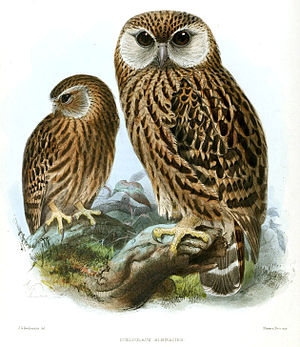Barnacle owl
| Barnacle owl | ||||||||||
|---|---|---|---|---|---|---|---|---|---|---|

Barnacle Owl ( Sceloglaux albifacies ) |
||||||||||
| Systematics | ||||||||||
|
||||||||||
| Scientific name of the genus | ||||||||||
| Sceloglaux | ||||||||||
| Kaup , 1848 | ||||||||||
| Scientific name of the species | ||||||||||
| Sceloglaux albifacies | ||||||||||
| ( GR Gray , 1844) |
The Weißwangenkauz (also Lachkauz , Sceloglaux albifacies ) was an owl, which occurred in two subspecies on the island of New Zealand. With the Maori it was called Whēkau. Other names were Hakoke or rock owl.
Description and way of life
When the European settlers arrived in New Zealand during the first half of the 19th century, the barnacle owl was still quite common. Bellows were brought to England, where they were first described as Athene albifacies by British ornithologist George Robert Gray in 1844 . In 1848 the owl was classified into the new genus Sceloglaux by the Darmstadt zoologist Johann Jakob Kaup . From 1880 the white-cheeked owls could also be seen in human care, e.g. B. in England, in Amsterdam, where an animal survived a year and in New Zealand with the well-known New Zealand ornithologist Sir Walter Buller.
The barnacle owl reached a length of 35 to 40 cm and a wing length of 26.4 cm. The weight was approx. 600 g. Its plumage was yellow-brown and striped dark brown on the top and bottom. Shoulders, wings and tail were banded with dirty white. The beak was black with a bright tip. The face veil was white. The eyes were yellow-brown. The feet were feathered yellow to reddish brown.
This bird species got the name "Laughing Owl" from its reputation. It sounded like a mixture of the glu glu glu of a turkey and human laughter.
The barnacle owl was a ground-breeder, which was its undoing mainly because of the introduced weasels. The nest, which usually consisted of two white eggs, was in hollows, on the bare ground or in the dried grass. The incubation period was 25 days. The breeding business was shared between males and females.
The owls apparently hunted their prey on foot on the ground. Their diet consisted of beetles, lizards, small birds, rats and mice.
Spread and extinction
Two subspecies were known of the barnacle owl. The red-eared owl or northern barnacle owl ( Sceloglaux albifacies rufifacies ) was native to the North Island of New Zealand in wooded areas at Mount Taranaki , a volcano near the city of New Plymouth , and in the Wairarapa region and is native to around 1890 by animal species such as cats and weasels and rats as well as extinct due to habitat destruction .
The southern barnacle owl ( Sceloglaux albifacies albifacies ) or Lachkauz lived in the alpine regions of the South Island, especially in Nelson, Canterbury and Otago. Further specimens were discovered on Stewart Island in 1880 . The last documented report was in July 1914 when a dead specimen was found on the Blue Cliffs in the Canterbury region.
Unconfirmed sightings continued into the 1940s and egg fragments were found near Canterbury by 1960.
literature
- Errol Fuller: Extinct Birds . Viking / Rainbird, London 1987, ISBN 978-0-670-81787-0
- Tim Flannery, Peter Schouten: A Gap In Nature: discovering the world's extinct animals . Atlantic Monthly Press, New York 2001, ISBN 978-0-87113-797-5
- David Day: The doomsday book of animals: a natural history of vanished species . Viking Press, New York 1981, ISBN 978-0-670-27987-6
Web links
- Copy in the Zoological Museum Amsterdam and description (English)
- Description and photo of a live animal on Owlpages
- Whekau - The Laughing Owl
- Sceloglaux albifacies in the Red List of Threatened Species of the IUCN 2008. Posted by: BirdLife International, 2004. Retrieved on January 4 of 2009.

